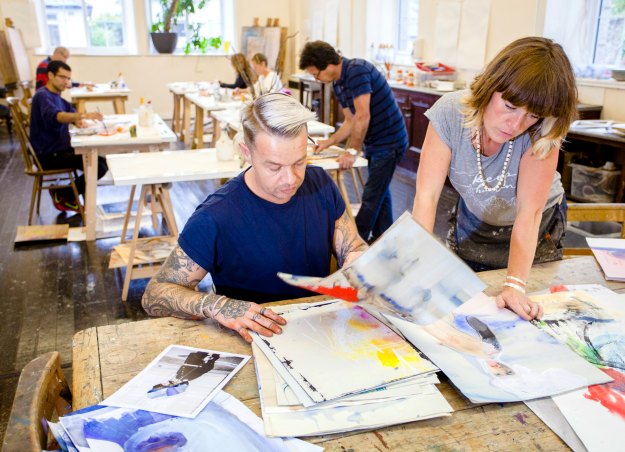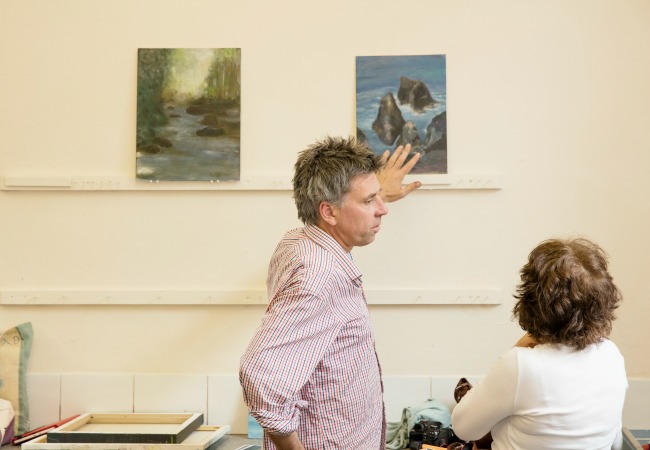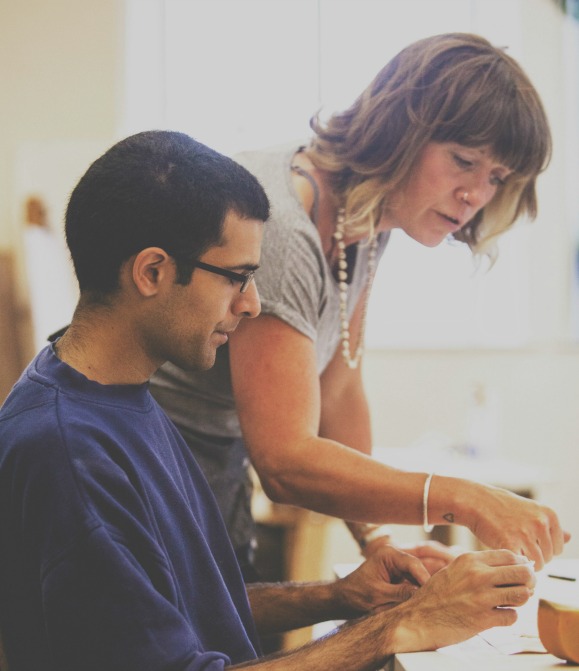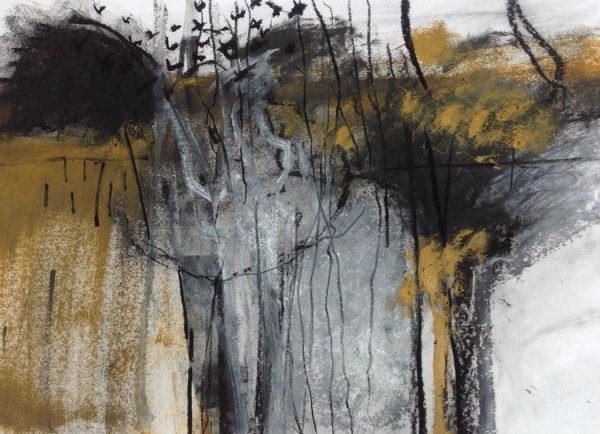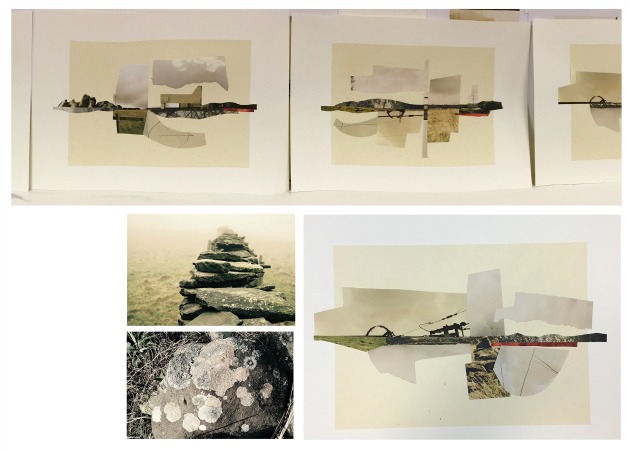With the final show for the Mentoring Programme opening later this month, Alex Wade visited Newlyn School of Art for the October issue of Cornwall Today Magazine to see the popular yearlong Mentoring and Defining Practice courses in action…
Henry Garfit is – quietly – on good form. We’re talking in one of the airy rooms of Newlyn School of Art, atop Chywoone Hill in Newlyn. As ever, the sea of Mount’s Bay shimmers beneath us; unusually, a copy of Monocle magazine is in Garfit’s hands. “It’s great to have been featured in Monocle,” says Garfit, the man who, after three years of hard graft, opened the School in August 2011. “We’re thrilled. It’s a wonderful platform for us.” Garfit is alluding to a seven-page feature in the July/August issue of Monocle – and he’s right. Monocle is a modern-day publishing success story, with annual sales of 81,000 copies and bureaux around the world. It’s a must-read on global affairs, business and culture with an international reach; to merit extended coverage within its pages is no mean feat.
“One of our students was also recently featured on BBC’s Countryfile,” adds Garfit. Softly spoken and modest, Garfit mentions student Anita Reynolds’ slot on Countryfile almost reluctantly. He’s happier for actions to speak louder than words, but if you ask him a question, he will give a thorough, grounded and sensible answer. Mine was simple: how is it that the School has gone so well? It’s not just Monocle and the BBC who have featured Garfit’s School and its students; it’s all manner of other media, from the FT and Sunday Times to The Spectator and The Economist. And the School’s numbers tell their own story: in 2016, 1,000 students attended the School, participating in short painting courses, life drawing classes, printmaking courses, Tresco painting holidays and any number of other activities. This year, yet more are set to come through the doors of the former primary school, a large, rambling Victorian building overlooking St Michael’s Mount. How has Garfit done it?
“There’s been a lot of hard work,” he says, “but our success is down to the 35 artists we have here, teaching students. They’ve all bought into what we’re trying to do: to be a dynamic and innovative art school offering high-quality art courses with respected artists generously sharing their practices and the things they are passionate about. It’s been a very collaborative venture from the start. And two courses especially have really helped – our Mentoring course, and the Defining Practice course.”
Garfit explains that the idea of a mentoring course evolved during the first two years of the School’s existence. “We realised that people got a lot out of energising their art practice over short courses – they enjoy rubbing shoulders with professional artists and learning from them – so, in 2013, we started a year-long Mentoring course. It runs over six weekends, each about eight weeks apart, starting in January and ending in late November. The course is non-practical in that the work is all done at home between sessions and brought in to be discussed on the weekends. At the end, students exhibit their work at the PZ Gallery in Penzance. This year’s Mentoring group will have a fantastic final exhibition which can be seen at PZ Gallery in November.” Garfit pays tribute to artist Jesse Leroy Smith, one of the most respected figures in the Cornish art world. “Jesse has been central to the success of the Mentoring course. He’s well-known for his boundless generosity to other artists. It’s clear to see on this course, which he heads. Jesse pulls together a different group of visiting contemporary artists each weekend to help the students see how other artists work and how they navigate getting their work out into the world.”
Smith explains that this – gaining the confidence to get the work out there and seen – is the essence of the mentoring course. “The course is for artists who are at the point of launching themselves professionally and need that last bit of support to understand how to best get across their work and what it is about, by using the most appropriate materials or media, how they present it, what artists they compare themselves to and where they choose to exhibit or promote their work. We aim to give them confidence in what they’re doing and to understand the context in which they are working.”
The mentoring course usually has 15 to 16 participants, coming from different backgrounds and different parts of the country. Some have done degrees in Fine Art, while others may have exhibited in galleries – but neither are a prerequisite. All are chosen, says Smith, because: “They are talented but also able to work in a group and support each other. They need to be listeners as much as being there to discuss their own work.”
A similarly cooperative spirit underpins the School’s more practical Defining Practice course, which is co-headed by Smith and Faye Dobinson, another popular and hugely respected artist. Now in its third year, the course, says Dobinson, “is tailored to those who want to create a body of work over a year through which they might gain a stronger sense of their own artistic voice and the methods, media and processes that are most suited to their work”. She continues: “While the Mentoring course is for people just about to begin careers as professional artists, Defining Practice is for artists who aren’t so far advanced, who want to invigorate their practice and create a coherent body of work. We aim to encourage them in a group dynamic, so students can share discoveries, influences and connections from contemporary artists to historical references – and so that they can be inspired by the artistic journeys of fellow students.”
The Defining Practice course consists of two groups taught either over six weekends, or on Mondays and Tuesdays, for a year. “There’s no pressure,” adds Dobinson. “Students have time to play and discover themselves.” Studio sessions are combined with one-to-one tuition and group tutorials, with the focus ranging from sketchbooks, printmaking and photography to painting and portraits. Garfit says that the courses on mentoring students and defining their practices “have made a real difference to students – feedback is fantastic for both”, but yet more tangible are the School’s live and kicking success stories. Take Rachel Ara, who attended the 2014 Mentoring course, and a year later was awarded the esteemed International Aesthetica Art Prize. Or a recent graduate who was awarded a place at the Royal College of Art, and Kathryn Campbell, a student last year, who has been shortlisted for the annual National Portrait Gallery exhibition. “Others have been taken on by leading London galleries, some have had their work covered by the art press and national newspapers, and many have been awarded Arts Council grants to further their work,” says Garfit.
No wonder he’s on good form – and he’s got yet more reasons to be cheerful with the launch of both a partnership with the National Trust (which, next summer, will see workshops held on trust sites in Cornwall) and unique, limited edition Newlyn School of Art artist label wines with Polgoon Vineyard (see page 76). Ever discreet, Garfit has the bearing of a man who is content, yes, but who also plans on a achieving a whole lot more. His determination is unquestionable, but Garfit – himself also a practising artist – is not one for blowing his own trumpet. The last words, then, go to two ex-students Anita Reynolds, the former Newlyn School of Art Mentoring student who recently wowed viewers of Countryfile and Mike Thorpe who attended the Defining Practice Course in 2015.
Now part of an emerging artist hub in a disused clay factory on the edge of Dartmoor, with two shows already in the diary for 2018, Anita Reynolds says: “One thing that is hard to find as an artist is decent criticism, but Newlyn School of Art’s one-year Mentoring course delivers just that: constructive criticism, delivered in a supportive way, by established artists. Add the practical advice about developing your practice and the company of like-minded fellow students, and you have a winning combination. “I’m currently working on a large project to produce an artwork to represent every one of the 365 square miles that make up the Dartmoor National Park. The course has given me the confidence I lacked before: my aim now is to get my work out of the comfort of the West Country and head up to the big smoke.”
Of the Defining Practice Course Mike Thorpe says: “I first found out about the Defining Practice Course, and the Newlyn School of Art, when researching for a course that would help me to establish an art practice, alongside my existing graphic design business. After many years of prevarication, I rented an ex-taxi rank in my hometown of Macclesfield in Cheshire with the intent of setting up a studio. Standing in that empty space, I was slightly paralysed by the many possibilities, struggling to define exactly what I wanted to explore or achieve. Hence the discovery of the school, which appeared to be unlike anything else I could find, certainly in the north of England. So in 2015 I committed to a year of travelling up and down the M6 and M5 and found myself immersed in learning new techniques, discussing work with fellow artists and beginning to find a personal route through this new world.
It was very refreshing to have tutorials with practising artists who have all been through similar experiences and are able to give honest appraisals of your work. I soon realised that the defining of my art practice will be an ongoing process, with this course as a fantastic kick-starter. Since then I have completed the Mentoring Course. I have also been admitted into the Newlyn Society of Artists and I am hoping to work with more artists from the South West. Recently, I moved into larger premises and now share the studio with four other artists. The appeal of collaboration has been borne out of the emphasis on the Defining Practice course of critical and constructive discussion around each others’ work. It is a safe place in which to experiment, develop both individually and as a group”.
The closing date for applications to Newlyn School of Art’s 2018 Mentoring and Defining Practice courses is December 1, 2017. Among the School’s 35 tutors are leading artists including Gareth Edwards, Jessica Cooper, Sam Bassett, James Hankey, Kate Walters, Jesse Leroy Smith, Faye Dobinson, Rachael Reeves, Marie Claire Hamon, Nina Royle and Jack Davis among others who work in Cornwall, while the many visiting tutors include Jacques Nimki from London and Louise Thomas from Berlin. This year’s Mentoring programme final exhibition can be seen at PZ Gallery from November 24 to 26, 2017. More information on Newlyn School of Art’s longer courses can be found on their COURSES PAGE
